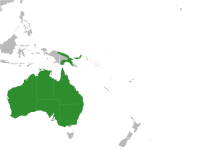
Lizard is the common name used for all squamate reptiles other than snakes, encompassing over 7,000 species, ranging across all continents except Antarctica, as well as most oceanic island chains. The grouping is paraphyletic as some lizards are more closely related to snakes than they are to other lizards. Lizards range in size from chameleons and geckos a few centimeters long to the 3-meter-long Komodo dragon.

Delma is a genus of lizards in the family Pygopodidae. The genus Delma contains 22 valid described species, all of which are endemic to Australia.
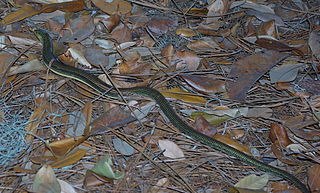
Ophisaurus is a genus of superficially snake-like legless lizards in the subfamily Anguinae. Known as joint snakes, glass snakes, or glass lizards, they are so-named because their tails are easily broken; like many lizards, they have the ability to deter predation by dropping off part of the tail, which can break into several pieces, like glass. The tail remains mobile, distracting the predator, while the lizard becomes motionless, allowing eventual escape. This serious loss of body mass requires a considerable effort to replace, and can take years to do so. Despite this ability, the new tail is usually smaller than the original.
Many vertebrates are limbless, limb-reduced, or apodous, with a body plan consisting of a head and vertebral column, but no adjoining limbs such as legs or fins. Jawless fish are limbless but may have preceded the evolution of vertebrate limbs, whereas numerous reptile and amphibian lineages – and some eels and eel-like fish – independently lost their limbs. Larval amphibians, tadpoles, are also often limbless. No mammals or birds are limbless, but some feature partial limb-loss or limb reduction.

Legless lizard may refer to any of several groups of lizards that have independently lost limbs or reduced them to the point of being of no use in locomotion. It is the common name for the family Pygopodidae. These lizards are often distinguishable from snakes on the basis of one or more of the following characteristics: possessing eyelids, possessing external ear openings, lack of broad belly scales, notched rather than forked tongue, having two more-or-less-equal lungs, and/or having a very long tail.

The striped legless lizard is a species of lizards in the Pygopodidae family endemic to Australia. As of 2015 it is threatened with extinction, with few habitats left.
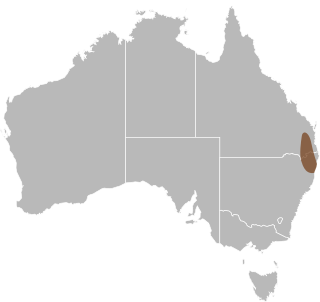
The collared delma or adorned delma is the smallest species of lizard in the Pygopodidae family endemic to Australia. Pygopopdids are legless lizards, so are commonly mistaken for snakes. They are distributed mainly across south-east Queensland and northern New South Wales, in both forests and some suburban areas. They are active during the day, seen foraging and hunting for small insects.

The Brigalow scaly-foot, also known as the Queensland snake-lizard, is a species of legless lizard in the family Pygopodidae. It is endemic to Australia and is the only species in the monotypic genus Paradelma.

Burton's legless lizard is a species of lizard in the family Pygopodidae. The species lacks forelegs and has only rudimentary hind legs. Pygopodid lizards are also referred to as "legless lizards", "flap-footed lizards" and "snake-lizards". This species is native to Australia and Papua New Guinea.

The common scaly-foot is a widespread species of legless lizard in the Pygopodidae family. It is endemic to Australia.

The Carphodactylidae, informally known as the southern padless geckos, are a family of geckos, lizards in the infraorder Gekkota. The family consists of 34 described species in 7 genera, all of which are endemic to Australia. They belong to the superfamily Pygopodoidea, an ancient group of east Gondwanan geckos now only found in Australasia. Despite their well-developed limbs, molecular phylogenies have demonstrated that Carphodactylidae is the sister group to Pygopodidae, a highly specialized family of legless lizards.
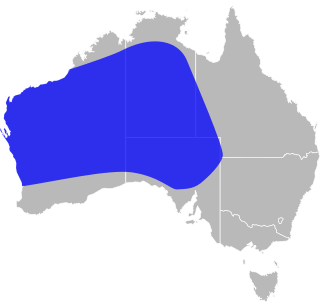
The hooded scaly-foot, also known as western scaly-foot, black-headed scaly-foot or western hooded scaly-foot, is an endemic Australian legless lizard of the family Pygopodidae.
The eastern hooded scaly-foot or eastern scaly-foot is a species of flap-footed lizard found in the complex heaths of the lower west coast and the spinifex grasslands of mainland Australia. They are popular pets and are often mistaken for snakes due to their limbless appearance.

Pygopodoidea is a gecko superfamily and the only taxon in the gekkotan subclade Pygopodomorpha. The clade includes three Australasian families: Diplodactylidae, Carphodactylidae, and Pygopodidae. Traditional gekkotan systematics had considered Diplodactylidae and Carphodactylidae as subfamilies of the family Gekkonidae, but recent molecular work have placed Pygopodidae within Gekkonidae making it paraphyletic. These analyses have shown support of Pygopodidae and Carphodactylidae being sister taxa, with Diplodactylidae occupying a basal position in Pygopodoidea.

Delma butleri, also known commonly as Butler's legless lizard, Butler's scalyfoot, the spinifex snake-lizard, and the unbanded delma, is a species of lizard in the family Pygopodidae. The species is endemic to Australia.
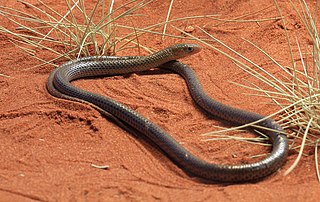
Delma nasuta, also known as sharp-snouted delma or sharp-snouted legless lizard, is a species of lizard in the Pygopodidae family endemic to Australia.

The excitable delma is a species of lizard in the Pygopodidae family endemic to Australia. The lizard gets its name from its active and jumpy defense mechanism. It will erratically jump multiple times in succession, each jump pivoting its body in a different direction. D. tincta is a slender, long legless lizard that through evolution lost its limbs. It is found throughout Australia in a variety of habitats, and spends most of its time hiding. Due to its nocturnal nature, it is rare to spot in the wild. This legless lizard is small to moderate in size, with a tail that is three to four times its body length. The typical size of the excitable delma is 250 – 300 mm. This lizard is an insectivore and feeds on insects it finds when travelling through grass, logs, surface soil, and loose rocks. Like all pygopodids, the excitable delma is oviparous and only lays two eggs per clutch.

The Mallee worm-lizard , also known as the pink-nosed worm-lizard and the red-tailed worm-lizard, is a slender pygopid species that is endemic to Australia, with recorded distribution across the four southern mainland states, although its distribution is restricted in Western Australia and New South Wales.
The striated worm-lizard is a species of legless lizard in the family Pygopodidae. It is endemic to southern Australia. Commonly known as Striated worm-lizard but has also been referred to as the Striped or Lined worm-lizard due to its pattern of long, thin parallel streaks. Some populations such as those in WA and Kangaroo Island may have absent stripes or the lines present as lines of dots.

The olive legless lizard is a species of legless gecko from the Pygopodidae family. This species is commonly found throughout the Australian Capital Territory, New South Wales, Queensland and southeastern South Australia, mostly inhabiting areas consisting of dry to temperate southern grasslands and grassy woodlands.

